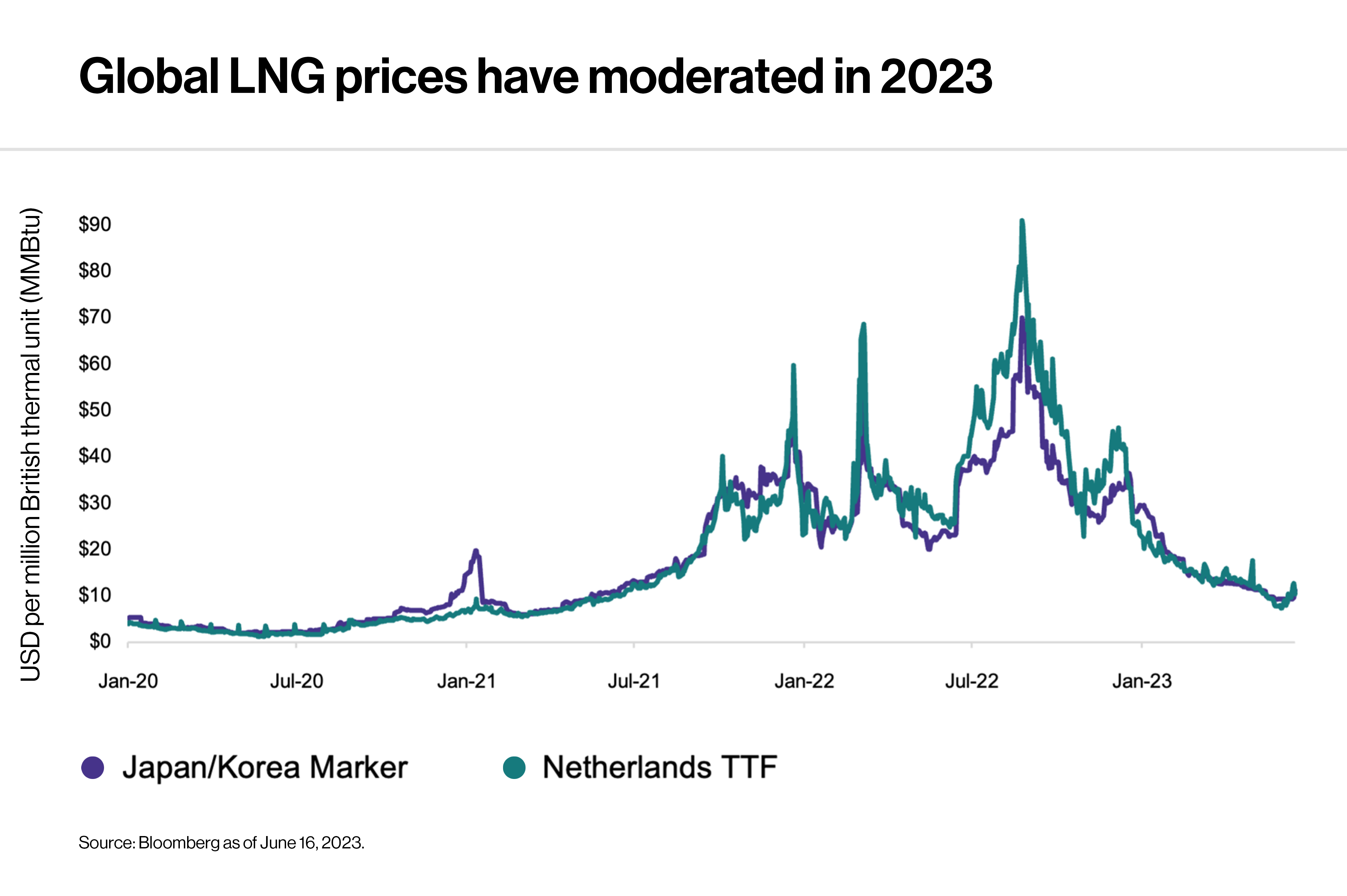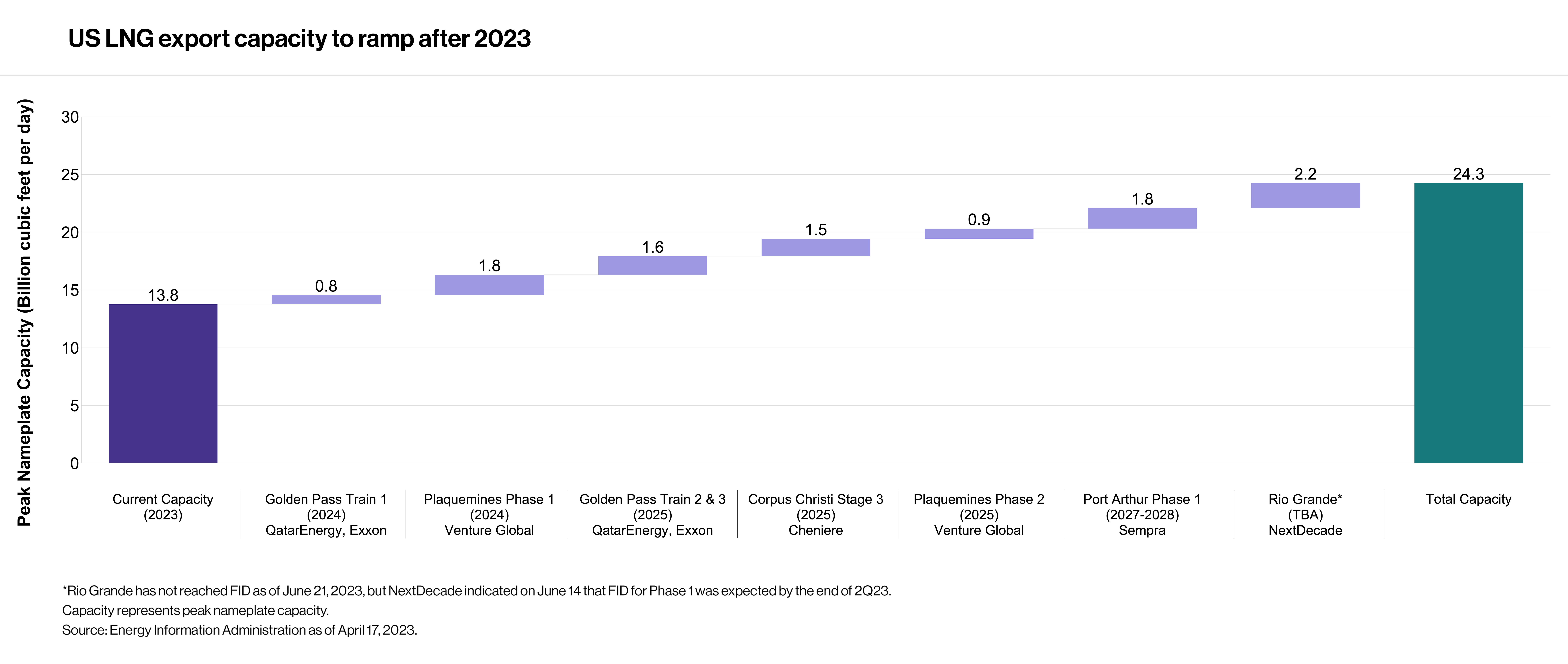VettaFi discusses LNG market weakness in 2023 and the positive takeaways from US LNG projects continuing to advance.
Summary
- A warm winter and mixed demand from Asia have weighed on global LNG prices in 2023 after a standout 2022.
- Despite market weakness, a handful of US projects have either begun construction or are nearing the start of construction. This provides visibility to meaningful LNG export capacity growth in the US and opportunities for midstream.
- Contracts to purchase LNG well into the 2040’s reinforces a positive long-term view for US natural gas production and global LNG demand.
A warm winter and a sluggish global economy have put a damper on LNG prices in 2023. Despite a challenging landscape, US LNG export projects continue to see positive progress with multiple facilities starting construction this year. Today’s note discusses the weakness in LNG markets in 2023, US export projects under development, and the positive implications from growing US LNG export capacity.
For more on LNG and ways midstream companies participate, please join our next 30-minute LiveCast on July 10 at 12:30 p.m. ET, “Energy Infrastructure Beyond Natural Gas: LNG and NGLs.” Register here.
LNG prices slide in 2023.
Global LNG prices spiked in 2022 following Russia’s invasion of Ukraine as Europe scrambled to replace Russian volumes and fill up storage ahead of winter. The unexpected, extended outage at Freeport LNG’s Texas facility following a fire on June 8, 2022 also put upward pressure on prices. European LNG prices topped out above $90 per million British thermal unit (MMBtu) in August 2022. The Japan/Korea LNG price marker peaked near $70 per MMBtu.
As shown in the chart below, a warm winter quickly sent prices back to earth. In Europe, natural gas storage exiting winter was 55.7% full – a record high for March 31. Ample inventories mean less demand for refilling storage, which has put pressure on prices. In Asia, LNG demand trends have been mixed with Japan particularly weak. Cheniere (LNG) noted on its early May earnings call that Chinese LNG imports were down 3% in 1Q23 relative to 1Q22 but leading indicators for demand were encouraging.

Some have raised concerns about the potential for US LNG cargo cancellations over the coming months. Cancellations probably depend on whether Asia can soak up incremental cargos as European imports likely moderate as storage fills. Cargo cancellations may sound ominous. However, US LNG facilities typically still collect a liquefaction fee even if their customers decide to cancel cargos as seen in 2020 (read more).
US LNG projects continue to progress.
Despite a weaker LNG market currently, a handful of US projects have reached final investment decision (FID) or are expected to reach FID soon. FID is the point at which a company commits to move forward with a project, having secured necessary financing and offtake agreements.
Venture Global announced FID for Phase 2 of its Plaquemines LNG facility in mid-March after lining up $7.8 billion in project financing. Days later, Sempra Energy (SRE) announced FID for Port Arthur LNG Phase 1, in which ConocoPhillips (COP) has a 30% interest. Earlier this month, NextDecade (NEXT) announced framework agreements with Global Infrastructure Partners (GIP) and TotalEnergies (TTE), whereby GIP and TTE would become investors in Phase 1 of Rio Grande LNG. NEXT expects FID for Phase 1 by the end of 2Q23. Also this month, Delfin Midstream announced a strategic investment from Mitsui O.S.K. Lines. The company is targeting FID on its first two floating LNG vessels offshore Louisiana this year.
No US LNG export capacity is starting up in 2023, which contributes to a tempered view for US natural gas prices in the near term. However, capacity should expand noticeably in 2024 and 2025 with QatarEnergy and Exxon’s (XOM) Golden Pass, Venture Global’s Plaquemines Phase 1, and Cheniere’s (LNG) Corpus Christi Stage 3 project. Incremental demand from new LNG facilities could be supportive for US natural gas prices beyond 2023.
With projects under construction and another FID expected imminently, peak nameplate US LNG export capacity is set to increase from 13.8 billion cubic feet per day (Bcf/d) to over 24 Bcf/d as shown below.

Notably, projects that are still in the early stages of development are signing long-term agreements with customers. Cheniere is developing additional expansion projects at Sabine Pass through Cheniere Energy Partners (CQP) and at Corpus Christi. Within the last week, Cheniere announced a 15-year purchase agreement with Equinor (EQNR) and a 20-year agreement with ENN LNG in connection with the Sabine Pass expansion. Last week, Venture Global announced a 20-year purchase agreement with a German energy company for its CP2 LNG project.
Not all projects have seen smooth sailing. In April, the Department of Energy issued a policy statement with more stringent parameters for extending permits to export LNG to countries without free trade agreements. Concurrently, the DOE denied Energy Transfer’s (ET) request for an extension for its export permit for Lake Charles LNG. ET’s request for rehearing was denied last week.
What does growing US LNG export capacity mean for midstream?
US LNG export projects continue to advance as customers agree to long-term purchase agreements into the 2040’s. This reinforces a constructive long-term outlook for US natural gas production and global natural gas demand. Before natural gas is liquefied and exported, it must be gathered, processed, and transported to LNG facilities – creating fee opportunities for midstream.
Some energy infrastructure names are directly involved in LNG export facilities like Cheniere (LNG) and NextDecade (NEXT). Others have interests in LNG facilities like Enbridge (ENB) with Woodfibre LNG in British Columbia or Kinder Morgan with Elba Island. Some companies play a supporting role by operating the pipelines that supply LNG facilities under long-term contracts (~20 years). For example, KMI has contracts to move 7 Bcf/d of natural gas to LNG facilities today, which will increase to 10 Bcf/d by the end of 2025.
Bottom Line
LNG prices have clearly moderated in a looser market environment this year. However, the long-term outlook for US LNG exports remains very strong as customers commit to the 15- or 20-year purchase agreements needed to underwrite additional export capacity. For midstream, LNG represents an important growth opportunity.
Related Research:
US LNG Projects a Mixed Bag Despite Strong Backdrop
LNG Has Haynesville Humming – Benefits Midstream/MLPs
For more news, information, and analysis, visit the Energy Infrastructure Channel.

